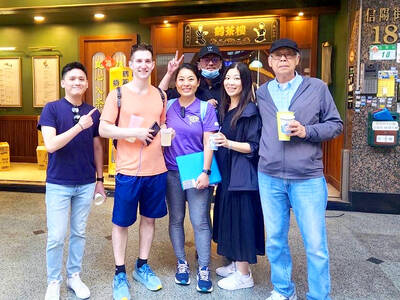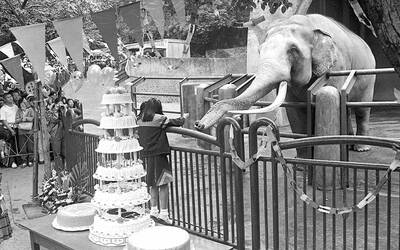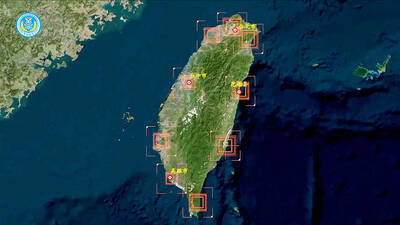Australia circa 2050, population 35 million, rising sea levels have flooded the Gold Coast resort region, apartment blocks are now used to grow food and people commute in monorail pods above the sea.
In another city, Australians live on floating island pods with apartments both below and above sea level. The population has shifted from land to the sea because of the sky-rocketing value of disappearing arable land.
Climate change has also forced many Australians to move inland and create new cities in the outback, relying on solar power to exist in the inhospitable interior.
These are just a few urban scenarios by some of Australia’s leading architects short-listed for Ideas for Australian Cities 2050+, to be presented at this year’s Venice Architecture Biennale.
While these images may sound like science fiction, many architects and demographers say Australian cities must radically transform to cope with the pressures of population growth and climate change or face social unrest and urban decay.
“If we don’t get this right ... all hell breaks loose, or our cities break down, there’s not enough water, there’s not enough power,” said Bernard Salt, one of Australia’s leading demographers.
Australia survived the global financial crisis, due largely to China buying its resources, and while resource exports will continue to bolster its economy for decades, future prosperity may be threatened by a growing, ageing population, according to an Australian government report released last month.
The report said Australia’s population was set to rise by 60 percent to 35 million by 2050, mainly through migration, yet cities are already groaning under the present population.
“One of the major frontier issues for Australia over the next decade will be the future of our cities,” said Heather Ridout, chief executive of the Australian Industry Group, which is calling for major infrastructure investment in cities.
Among the beneficiaries of such development would be property firms like Lend Lease, Stockland and Mirvac Group, building material groups Boral Ltd and CSR, Australia’s top engineering contractor Leighton Holding Ltd, and the country’s biggest private hospital operator, Ramsay Health.
But demographers warn that Australian cities need to not only expand infrastructure, but ensure future residents have equal access to city facilities.
Race riots at Sydney’s Cronulla beach
in 2005 and a series of attacks against
Indian students in the past year are signs of growing social tensions in Australian cities, say demographers.
“If we have a rising population, we need to make sure that we have appropriate infrastructure, so that we don’t lose the social cohesion that we take for granted,” said Larissa Brown from the Centre for Sustainable Leadership. “We need affordable access to housing, to transport, to health care.”
While Australia is double the size of Europe, three-quarters of the country is sparsely populated countryside or harsh outback, leaving the bulk of the population to inhabit a thin strip down the southeast coast. Around 50 percent of the population lives in the three largest cities — Sydney, Melbourne and Brisbane — on a combined land area that is about the size of Brunei or Trinidad & Tobago.
TRANSPORT KEY TO FUTURE CITIES
Australia’s post-World War II sprawling suburbia is under strain because of inadequate transport and public facilities.
“We’re at risk of seeing increasingly dysfunctional cities ... we’re starting to see a sort of fragmentation and breakdown of the transport systems and increasing frustration for the residents of those cities trying to get around,” said Jago Dodson, urban researcher at Griffith University.
A State of Cities 2010 report released earlier this month said Australia’s major cities contribute nearly 80 percent of GDP, but warned that worsening urban congestion would have a serious negative impact on economic growth if not addressed.
The Bureau of Infrastructure, Transport and Regional Economics estimates the cost of road congestion for Australia’s cities was about US$8.7 billion for 2005. Left unchecked, this is projected to rise to US$18.2 billion by 2020.
“Urban congestion contributes to traffic delays, increased greenhouse gas emissions, higher vehicle running costs and more accidents,” said Infrastructure Minister Anthony Albanese.
“It is a tragedy that many parents spend more time traveling to and from work, than at home with their kids. Relieve urban congestion and we improve our quality of life as well as our productivity,” said Albanese.
Last month, a 10-year, US$45.6 billion transport blueprint was announced for Sydney that will see a new heavy rail network, 1,000 new buses and possibly a fast train linking Sydney with the port city of Newcastle, to its north.
Sydney, Australia’s biggest city, is daily gridlocked, forcing a motorist who travels 22km a day to spend three days stuck in traffic each year.
Private transport currently accounts for about 90 percent of urban journeys in Australia and Transurban Group, which operates the nation’s major tollways, believes car usage will continue to rise, despite a move to public transport.
“Despite concern about climate change, road use in our cities is predicted to grow significantly in the next 20 to 30 years,” said Transurban in a sustainability report last year.
“New road projects will increasingly be part of integrated transport solutions for entire cities or transport corridors.”
But the company warned future road projects will cost more to build and develop because of climate change, with Australia’s government seeking to introduce a carbon emissions trading scheme and pre-approval analysis of new projects’ climate impact.
Prime Minister Kevin Rudd’s government plans to invest US$32.8 billion in transport infrastructure in the next five years.
Improving efficiency in energy and transport infrastructure could increase GDP by nearly 2 percent, or the equivalent of US$68.5 billion, says Australia’s Productivity Commission.
Australia has one of the world’s highest home ownership rates, but the generational dream of a suburban home and garden looks set to be shattered.
Over the next few decades, more Australians will be living in high-density housing, in what some demographers call the ‘Manhattanization’ of cities.
A new Sydney urban plan released last month calls for 700,000 new dwellings by 2036, with 70 percent of development to occur within existing suburbs and only 30 percent in new suburbs.
If Sydney does not consolidate, the city would need to expand 1.5 times in size to accommodate its growing population and would run out of available land within 30 years, said the New South Wales state government plan.
Demographer Salt questions whether Australians will give up the Neighbours dream, citing the worldwide TV hit about life in a suburban Australian street. “Neighbours ... is absolutely integral to the Australian psyche,” said Salt, a partner at KPMG.
Whether Sydney adopts a Manhattan or low-rise European urban plan, a rising population will put more pressure on housing stock. Australia already has some of the most expensive house prices in the world and housing affordability is falling.
The Commonwealth Bank’s CommSec forecasts housing prices, which rose 12 percent last year, will rise by 8 percent to 10 percent this year because of a rising population and a lack of stock.
SUSTAINABLE CONURBATIONS
Australia has an inhospitable interior forcing more than a quarter of its 20 million people to live in the southeast corner, where the two biggest cities and jobs are located.
The projected population increase will impact heavily on Australia’s fragile environment and require urban planning to ensure future cities are environmentally sustainable.
Australians have the biggest houses in the world, nicknamed McMansions, and demographers say homes may need to be retro-fitted with water tanks and solar panels to make cities more sustainable and reduce their environmental footprint.
“A bigger Australia doesn’t mean deeper soils, it doesn’t mean larger river flows, it doesn’t mean more rainfall. We’re only bigger in one sense — the increase in the total number of humans crammed into the narrow coastal strip,” said Bob Carr, former New South Wales state premier.
Sydney this month began pumping desalinated ocean water to supplement its drinking water supplies, which are frequently threatened by drought. The plant will generate 250 million liters of water a day or around 15 percent of Sydney’s water supply.
Almost every major Australian city has a desalination plant under construction or already operational.
“Water’s going to be critical to the future of Australia, perhaps more than anything else,” said Mike Young from the Environment Institute at Adelaide University.
Australia has one of the world’s highest greenhouse gas emissions rates per capita, with about 80 percent of electricity generated by coal-fired power stations.
The country’s expanding population means it will need to produce 50 percent more power over the next 20 years, say energy experts, adding that a scarcity of water may stifle urban growth by threatening future power supplies as Australia’s coal-fired power generators are driven by steam and cooled by water.
Climate change will necessitate a change in Australia’s urban design, said last year’s Transforming Australian Cities report.
In January last year, a heat wave in Melbourne resulted in blackouts as power supplies failed and bushfires threatened to cut power to the entire city.
Melbourne’s rail system, designed for cooler conditions, overheated and failed, and water consumption trebled with the city’s water storage at only 33 percent capacity.
“On a daily basis we are witnessing the failure and shortcomings of these traditional systems,” said the report.
“Existing urban settlements and infrastructure are increasingly vulnerable and will need to be protected against these events. Compact cities with high densities are emerging as the most robust in the challenges posed by climate change.”

Eric Finkelstein is a world record junkie. The American’s Guinness World Records include the largest flag mosaic made from table tennis balls, the longest table tennis serve and eating at the most Michelin-starred restaurants in 24 hours in New York. Many would probably share the opinion of Finkelstein’s sister when talking about his records: “You’re a lunatic.” But that’s not stopping him from his next big feat, and this time he is teaming up with his wife, Taiwanese native Jackie Cheng (鄭佳祺): visit and purchase a

April 7 to April 13 After spending over two years with the Republic of China (ROC) Army, A-Mei (阿美) boarded a ship in April 1947 bound for Taiwan. But instead of walking on board with his comrades, his roughly 5-tonne body was lifted using a cargo net. He wasn’t the only elephant; A-Lan (阿蘭) and A-Pei (阿沛) were also on board. The trio had been through hell since they’d been captured by the Japanese Army in Myanmar to transport supplies during World War II. The pachyderms were seized by the ROC New 1st Army’s 30th Division in January 1945, serving

The People’s Republic of China (PRC) last week offered us a glimpse of the violence it plans against Taiwan, with two days of blockade drills conducted around the nation and live-fire exercises not far away in the East China Sea. The PRC said it had practiced hitting “simulated targets of key ports and energy facilities.” Taiwan confirmed on Thursday that PRC Coast Guard ships were directed by the its Eastern Theater Command, meaning that they are assumed to be military assets in a confrontation. Because of this, the number of assets available to the PRC navy is far, far bigger

The 1990s were a turbulent time for the Chinese Nationalist Party’s (KMT) patronage factions. For a look at how they formed, check out the March 2 “Deep Dives.” In the boom years of the 1980s and 1990s the factions amassed fortunes from corruption, access to the levers of local government and prime access to property. They also moved into industries like construction and the gravel business, devastating river ecosystems while the governments they controlled looked the other way. By this period, the factions had largely carved out geographical feifdoms in the local jurisdictions the national KMT restrained them to. For example,